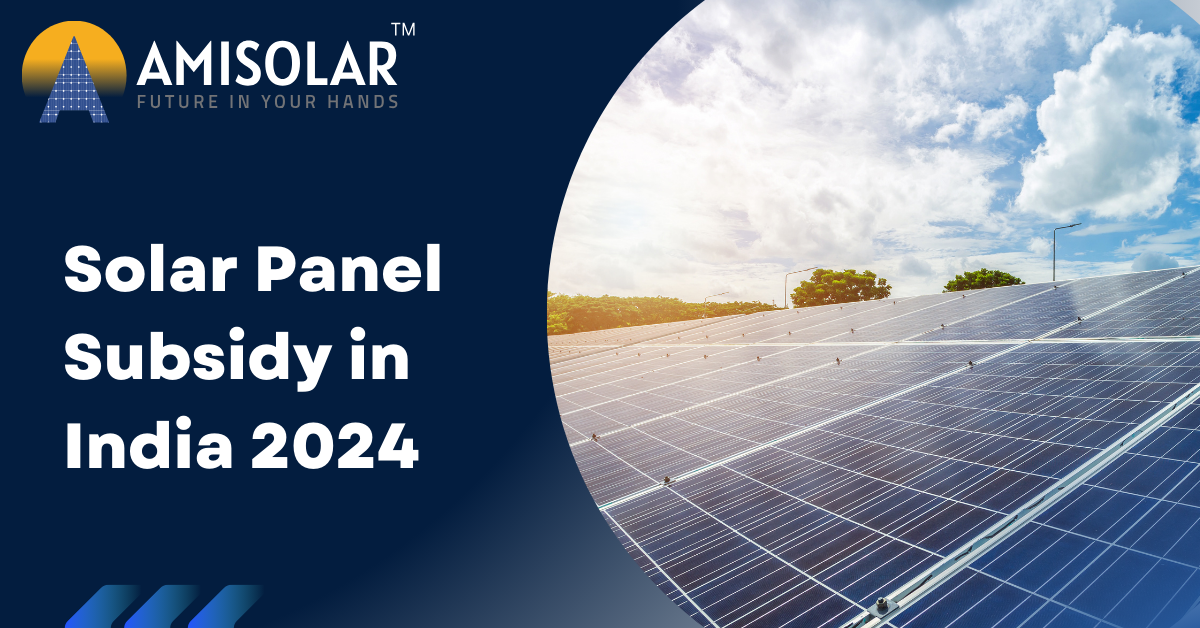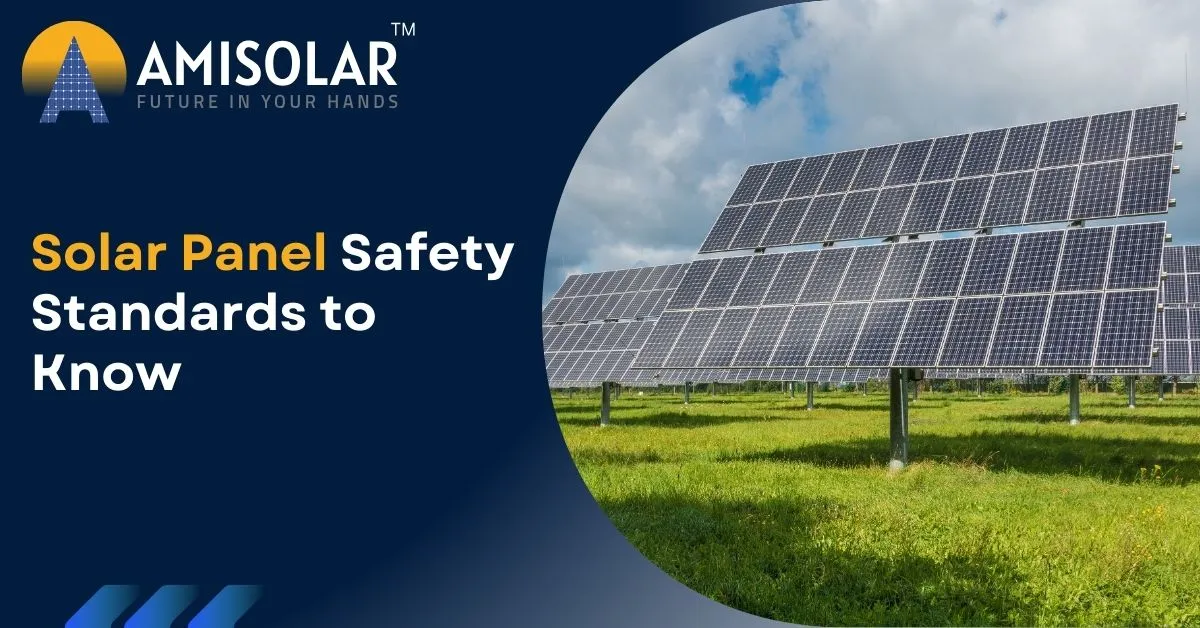As energy prices rise and concerns over the environment grow, many homeowners are turning to…

In recent years, solar energy has emerged as a promising solution to India’s growing energy needs while simultaneously reducing carbon emissions. To encourage the adoption of solar power across the country, the Indian government has implemented various subsidies and incentives. In this blog, we’ll delve into the world of solar panel subsidy in India, exploring what they entail, who qualifies, and how they can make solar power more accessible and affordable for everyone.
Table of Contents
Understanding Solar Panel Subsidies
Solar panel subsidies are financial incentives provided by the government to reduce the upfront cost of installing solar panel. These subsidies aim to promote renewable energy adoption and decrease reliance on traditional fossil fuels. In India, solar subsidy are typically offered at both the central and state levels, with each government providing different schemes and incentives.
Subsidy Prices
Certainly! Below is the revised table format with subsidy prices included:
| Rooftop Solar System Capacity | Applicable Subsidy (₹) |
|---|---|
| Up to 3KW | 18,000/KW |
| Above 3KW and up to 10KW | 9,000/KW* |
| Above 10KW | 1,17,000** |
| Resident Welfare Associations (RWA) /
Group Housing Societies (GHS) |
Rs. 9,000/- per KW
For Common Facilities up to 500 KW @ 10 KW per House, the Upper Limit includes Individual Rooftop Plants already installed by Individual Residents in that GHS/RWA at the Time of Installation of RTS for Common Activity. |
| Note:*₹18,000/kW for the First 3 KW and ₹9,000/KW for the Rest of the Capacity up to 10KW.
**The Subsidy Amount is Fixed for Rooftop Solar Systems above 10KW Capacity. |
|
Rates of subsidy for solar panels in India
Below is a simplified table outlining the rates of subsidy for solar panels in India:
| Type of Installation | Subsidy Rate (%) | Description |
|---|---|---|
| Residential Rooftop | Up to 40% | Subsidy provided under various state schemes |
| Institutional Rooftop | Up to 30% | Subsidy available for educational & govt. buildings |
| Commercial Rooftop | Up to 20% | Subsidy for commercial & industrial establishments |
| Off-grid Solar Systems | Up to 30% | Subsidy for standalone solar systems in remote areas |
| Solar Water Pumping Systems | Up to 30% | Subsidy for solar-powered irrigation pumps |
| Community Solar Projects | Up to 30% | Subsidy for solar projects serving communities |
Please note that these subsidy rates are indicative and subject to change based on government policies, schemes, and eligibility criteria. It’s advisable to verify the current subsidy rates and eligibility requirements from official sources or government agencies before proceeding with solar panel installations.
Government Initiatives and Schemes
The Indian government has launched several initiatives and schemes to encourage the adoption of solar energy. One notable program is the Jawaharlal Nehru National Solar Mission (JNNSM), which aims to achieve 100 GW of solar power capacity by 2022. Under JNNSM, various schemes such as rooftop solar subsidies, solar parks, and off-grid solar applications are implemented to incentivize solar power adoption across different sectors.
Jawaharlal Nehru National Solar Mission
The JNNSM was launched on January 11, 2010, with the primary goal of establishing India as a global leader in solar energy production. The mission aims to achieve this by promoting the development and deployment of solar power technologies across the country. One of its key objectives is to increase India’s solar power capacity to 100 gigawatts (GW) by 2022, a target that has since been revised to 450 GW by 2030, demonstrating India’s commitment to sustainable energy.
Central Subsidy Schemes
At the central level, the Ministry of New and Renewable Energy (MNRE) offers subsidies and incentives for solar power projects. These subsidies can include capital subsidies for solar power plants, financial assistance for off-grid solar installations, and incentives for solar water heating systems. Additionally, the government provides accelerated depreciation benefits and tax incentives to encourage investment in solar energy infrastructure.
Ministry of New and Renewable Energy
The genesis of MNRE can be traced back to the early 1980s when India first recognized the importance of harnessing renewable energy sources to meet its growing energy demands while reducing reliance on fossil fuels. Initially established as the Department of Non-Conventional Energy Sources (DNES) in 1982, the ministry underwent several transformations before being designated as MNRE in 2006. This change reflected a broader mandate to encompass not only non-conventional but also new and renewable energy sources, reflecting the evolving priorities and challenges of the energy sector. MNRE operates with a set of clear and ambitious objectives aimed at promoting the development and utilization of renewable energy technologies across India.
State-Level Subsidies and Incentives
In addition to central subsidy, many Indian states offer their own incentives and subsidies for solar power projects. These state-level schemes may include additional capital subsidies, electricity tariff incentives, and net metering policies that allow solar energy producers to sell excess power back to the grid at favorable rates. Some states also provide concessional loans and land subsidies to facilitate solar power project development.
Who Qualifies for Solar Subsidies?
Solar panel subsidy in India are available to a wide range of beneficiaries, including residential consumers, commercial and industrial establishments, government institutions, and agricultural enterprises. Eligibility criteria may vary depending on the specific subsidy scheme and location, but generally, individuals and organizations interested in installing solar panels can avail of these subsidies by meeting certain requirements outlined by the respective government authorities.
How to Apply for Solar panel subsidy?
Applying for solar panel subsidies in India typically involves several steps, which may vary depending on the specific scheme or subsidy program. Here’s a general outline of the process:
Research and Eligibility Check:
- Research the available subsidy schemes offered by the Ministry of New and Renewable Energy (MNRE), state governments, and local authorities.
- Check the eligibility criteria for the desired subsidy scheme, including factors such as project size, location, type of installation, and applicant category (residential, institutional, commercial, etc.).
Selecting a Vendor or Installer
- Choose a reputable solar panel vendor or installer with experience in handling subsidy applications.
- Ensure that the vendor/installer is accredited by relevant authorities and eligible to participate in subsidy schemes.
Documentation and Application Preparation
- Gather the necessary documents required for the subsidy application, such as proof of identity, address, property ownership, and project details.
- Work with your chosen vendor/installer to prepare the application documents, including project proposals, technical specifications, and cost estimates.
Submission of Application
- Submit the completed application along with the required documents to the designated authority responsible for administering the subsidy scheme.
- Ensure that the application is submitted within the specified deadline and meets all the criteria outlined in the scheme guidelines.
Application Review and Approval
- The authority responsible for administering the subsidy scheme will review the application to verify compliance with eligibility criteria and documentation requirements.
- If the application meets all the criteria and is approved, the applicant will be notified of the subsidy amount and any additional steps required to proceed with the installation.
Installation and Commissioning
- Once the subsidy approval is received, work with the vendor/installer to schedule the installation of the solar panel system.
- Ensure that the installation is carried out according to the approved specifications and guidelines provided by the subsidy scheme.
Claiming Subsidy and Final Inspection:
- After the installation is complete, submit any additional documentation or completion certificates required to claim the subsidy amount.
- The subsidy authority may conduct a final inspection to verify the installation and compliance with the scheme guidelines before releasing the subsidy payment.
Post-Installation Compliance:
- Ensure ongoing compliance with any post-installation requirements specified by the subsidy scheme, such as maintenance, monitoring, and reporting obligations.
It’s important to note that the process and requirements for applying for solar panel subsidies may vary between different subsidy schemes and government authorities. Applicants are advised to thoroughly review the scheme guidelines and seek guidance from authorized vendors or subsidy agencies to ensure a smooth and successful application process.
How Can We Help?
Ready to make the switch to solar energy? AmiSolar has got you covered! We offer hassle-free solar installations that are both reliable and efficient. Our team is experienced, and our solar products are top-notch, ensuring you get the best value for your money. Whether it’s for your home or business, we’ve got solutions tailored to meet your energy needs and save you money in the long run. Plus, our Integrated InRoof system not only generates clean energy but also looks great by seamlessly blending solar panels into your roof. With nationwide delivery and a commitment to excellence, AmiSolar is your partner for a brighter, greener future!
Frequently Asked Questions
What are solar panel subsidies?
Solar panel subsidies are financial incentives provided by the government to reduce the upfront cost of installing solar panels. These subsidies aim to promote the adoption of renewable energy and decrease reliance on traditional fossil fuels.
Who is eligible for solar panel subsidies in India?
Eligibility criteria for solar panel subsidies in India vary depending on the specific scheme and location. Generally, residential consumers, commercial and industrial establishments, government institutions, and agricultural enterprises may qualify for subsidies.
What types of solar installations are eligible for subsidies?
Various types of solar installations are eligible for subsidies, including residential rooftops, institutional rooftops, commercial rooftops, off-grid solar systems, solar water pumping systems, and community solar projects.
How do I apply for solar panel subsidies?
The application process for solar panel subsidies typically involves researching eligible schemes, selecting a reputable vendor or installer, preparing application documents, submitting the application to the designated authority, and following up on the approval process.
What documents are required for the subsidy application?
Required documents may include proof of identity, address, property ownership, project proposals, technical specifications, and cost estimates. The specific documentation may vary depending on the subsidy scheme and applicant category.
What is the role of the Ministry of New and Renewable Energy (MNRE) in solar subsidies?
MNRE plays a central role in formulating policies, implementing subsidy schemes, and providing financial assistance for solar power projects at the central level in India.
Are there any post-installation obligations for subsidy recipients?
Subsidy recipients may be required to comply with post-installation requirements such as maintenance, monitoring, and reporting obligations to ensure ongoing compliance with scheme guidelines.
Can I combine multiple subsidies for my solar installation?
In some cases, it may be possible to combine multiple subsidies for solar installations, depending on the eligibility criteria and guidelines of the respective schemes. It’s advisable to consult with authorized vendors or subsidy agencies for guidance on maximizing subsidy benefits.
Conclusion
Solar panel subsidy play a crucial role in promoting the widespread adoption of solar energy in India. By making solar power more accessible and affordable, these subsidies contribute to India’s renewable energy goals while offering numerous benefits to individuals, businesses, and the environment. As solar technology continues to advance and government support remains strong, the future looks bright for solar power in India, driving sustainable development and energy security for years to come.


